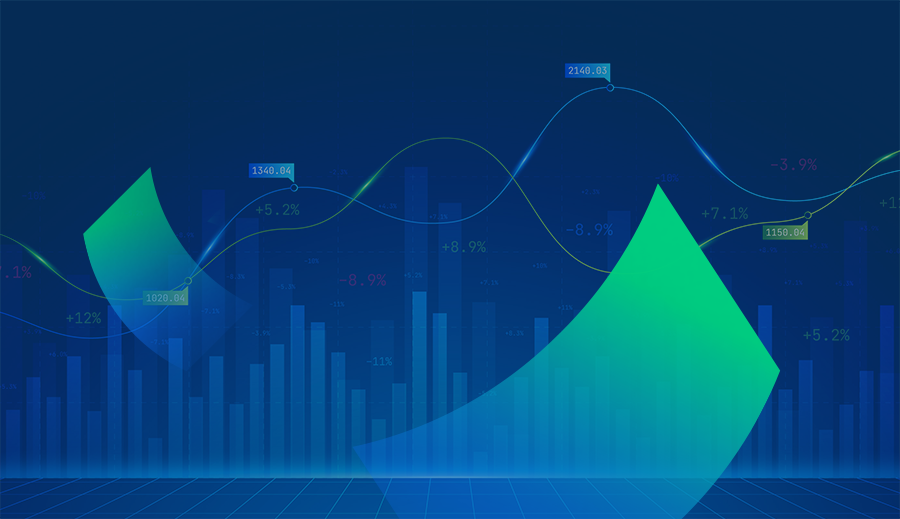This post is the third edition of our ‘The Rise of the AI-Powered CFO’ series.
As financial technology and artificial intelligence continue to advance, the role of the CFO is evolving. Traditionally, CFOs were responsible for overseeing financial operations and providing insights based on historical data. However, with the abundance of data available and the increasing complexity of business environments, today’s CFOs are expected to be more than just number crunchers.
The rise of AI-powered software solutions is transforming CFOs into strategic partners, leveraging intelligent forecasting and decision-making strategies to drive business growth. In this article, we will explore how AI is reshaping the CFO role in forecasting and what it takes for finance leaders to become successful AI-powered CFOs.

Challenges of Traditional Forecasting
Before the emergence of AI, traditional forecasting methods relied heavily on historical data and trends. This approach often led to inaccurate predictions due to unforeseen market changes or disruptive events. Additionally, the manual process of collecting and analyzing data was not only time-consuming but also prone to human error.
Traditional forecasting methods struggled to account for multiple variables simultaneously. This limitation resulted in a narrow view and provided limited insights, making it challenging for CFOs to make informed decisions and offer accurate forecasts. These challenges included:
- Data volume and complexity: CFOs frequently had to sift through vast quantities of data from both internal and external sources. The task became even more daunting when it involved integrating diverse data types, such as financial, operational, and external market data, complicating the derivation of meaningful insights for forecasting.
- Rapid market changes: The business landscape could shift dramatically due to new technologies, regulatory changes, or global events. Traditional methods, which may not account for such rapid changes, often left CFOs struggling to maintain accurate and timely forecasts.
- Forecasting accuracy: The inherent uncertainty in business operations, affected by factors like consumer demand, supply chain disruptions, and economic fluctuations, made achieving high forecasting accuracy a significant challenge for CFOs.
- Intensiveness: Traditional forecasting processes usually required substantial human effort and time for data collection, analysis, and model adjustments. This approach was not only inefficient but also delayed decision-making.
- Risk management: Effectively managing financial risk necessitated the analysis of a wide array of factors, from market volatility to credit risk. Traditional models often failed to capture the full spectrum of risk or how different risks interrelated.
- Integration of qualitative data: While qualitative data, such as consumer sentiments or regulatory changes, is crucial for accurate forecasting, it proved difficult to quantify and integrate into traditional models.
- Regulatory compliance and privacy: With an increasing focus on data protection and privacy, CFOs had to ensure that their forecasting practices complied with laws and regulations. This requirement added another layer of complexity to the forecasting process.
The traditional forecasting methods that once defined the CFO’s role are becoming increasingly insufficient in today’s dynamic and data-driven business environment. The challenges outlined previously underscore the limitations of these methods, highlighting the need for a more sophisticated, accurate, and adaptable approach to financial forecasting. This necessity paves the way for the integration of AI and machine learning technologies, heralding a new era for the CFO role.
AI-powered forecasting not only addresses these challenges but also equips CFOs with the tools to transform uncertainty into a strategic advantage.

How AI Can Assist CFOs with Forecasting
AI-powered forecasting software solutions have revolutionized the way CFOs approach financial planning and analysis. Leveraging machine learning algorithms, these solutions can quickly analyze vast amounts of data from multiple sources in real-time, providing accurate and timely insights.
Furthermore, AI-powered tools utilize predictive analytics to identify patterns and trends that might be undetectable by humans, enabling CFOs to make data-driven decisions with a high level of confidence. This technology also factors in multiple variables simultaneously, offering a comprehensive view of the business landscape and allowing finance leaders to identify potential risks and opportunities.
Reflecting on the challenges identified in the previous chapter, let’s explore how AI addresses each one:
- Data volume and complexity: AI’s ability to process large datasets facilitates the integration and analysis of varied data sources, including unstructured data. Machine learning models can uncover hidden patterns and dependencies, offering insights that were previously difficult or impossible to obtain.
- Rapid market changes: Leveraging real-time data and predictive analytics, AI equips CFOs with the agility to adjust forecasts promptly in response to market shifts. AI models, continuously updated with new data, ensure forecasts remain relevant and accurate, enabling proactive decision-making.
- Forecasting accuracy: Advanced algorithms that learn from historical trends improve forecasting accuracy over time. These models identify non-obvious correlations between variables, enhancing the predictive power of financial forecasts and bolstering CFOs’ decision-making confidence.
- Intensiveness: AI automates labor-intensive aspects of the forecasting process, from data collection to analysis. This not only accelerates the process but also minimizes human error, making it more efficient.
- Risk management: AI’s analysis of large datasets can more effectively identify potential risks and their interconnections. Through detailed scenario analyses and simulations, AI aids CFOs in understanding the potential impacts of various risk factors, enabling robust risk management strategies.
- Integration of qualitative data: Utilizing NLP and sentiment analysis, AI can interpret and quantify qualitative data from various sources. This approach allows for incorporating insights from qualitative data into quantitative models, providing a nuanced understanding of potential future trends.
- Regulatory compliance and privacy: AI technologies can incorporate compliance and data protection mechanisms, such as data anonymization and secure processing protocols. This ensures forecasting practices comply with regulatory requirements and maintain the confidentiality and integrity of financial data.
AI has emerged as a valuable tool for CFOs, optimizing financial forecasting processes and enabling data-driven decision-making. As this technology continues to evolve, it is expected to play an increasingly critical role in the future of finance forecasting. So, it is imperative that CFOs embrace AI-powered tools to stay ahead of the curve?

Future Trends: How AI Will Further Revolutionize Forecasting
As technology advances, the potential for AI in financial forecasting continues to expand, promising transformative changes that could redefine the finance landscape. The integration of AI into forecasting goes beyond enhancing accuracy or efficiency; it’s about fundamentally reshaping business planning for the future. Here are some key future trends set to shape financial forecasting:
Integration with Other Business Functions
In an increasingly interconnected and data-driven environment, AI-powered forecasting tools will become crucial to organizational strategy. By integrating with key business functions like sales, operations, and supply chain management, these tools will provide CFOs a comprehensive view of their organizations. This holistic approach fosters a symbiotic relationship where forecasting informs strategies across all departments, enhancing decision-making with agility.
More Sophisticated Predictive Analytics
AI’s future in forecasting will bring advanced sophistication in predictive analytics. Utilizing deep learning and natural language processing, AI will derive insights from complex datasets, enabling finance professionals to forecast with unprecedented precision. Predictive analytics will evolve to interpret data, context, sentiment, and subtle trends, offering highly accurate financial forecasts.
Enhanced Automation
AI development is heading towards comprehensive automation in financial forecasting, extending beyond simple tasks to complex analytical processes. This will not only streamline forecasting but also reduce human error, allowing finance teams to focus on strategic decision-making and enhancing their strategic role within organizations.
Adoption by Small and Medium-sized Businesses
With AI becoming more accessible and affordable, small and medium-sized businesses (SMBs) will increasingly adopt AI-powered forecasting tools, leveling the competitive field. The growth of cloud-based AI solutions will support this trend, providing scalable and cost-effective forecasting solutions for businesses of all sizes.
Human-AI Collaboration
Forecasting’s future lies in the symbiotic relationship between CFOs, finance teams, and AI systems. This partnership will combine AI’s computational power with human strategic insight, leading to more informed and nuanced decision-making.
Real-time Forecasting
AI will enable real-time forecasting, continuously updating predictions with new data. This capability will allow finance leaders to adapt strategies in real-time, transforming financial planning from a periodic process into a continuous, proactive strategy.
The future of AI in financial forecasting heralds a new era of strategic planning, characterized by data-driven insights, integration across business functions, and the ability to adapt strategies in real-time. As AI technologies evolve, CFOs and finance teams will lead increasingly sophisticated, efficient, and dynamic forecasting processes, driving their organizations toward success in a rapidly changing global economy. As the saying goes, “the best way to predict the future is to create it,” and with AI as an ally, CFOs are well-positioned to lead their organizations into a successful direction. So, in conclusion, embracing AI-powered forecasting tools is not just an option but a necessity for finance leaders looking to stay ahead of the curve.




